Page 187 of 389
185
4008_en_Chap07_info-pratiques_ed01-2014
F Push the repeater towards the rear to disengage it.
F D isconnect the repeater connector.
F
C
hange the repeater unit.
to
reassemble, carry out these operations in reverse order.
Contact a P
e
uge
Ot
dealer or a qualified workshop to obtain replacement repeaters.
Changing direction indicator side repeaters
Door mirror spotlamps
You should contact a Pe ugeOt dealer or a qualified workshop for the replacement of the light
emitting diode - LeD .
7
Practical information
Page 189 of 389
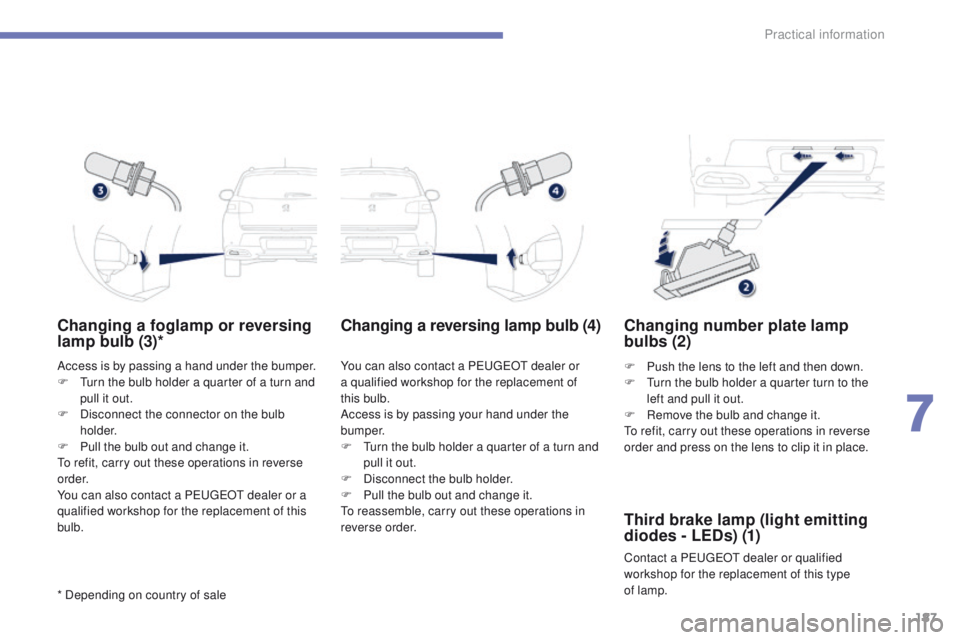
187
4008_en_Chap07_info-pratiques_ed01-2014
Changing a foglamp or reversing
lamp bulb (3)*
Access is by passing a hand under the bumper.
F tu rn the bulb holder a quarter of a turn and
pull it out.
F
D
isconnect the connector on the bulb
h o l d e r.
F
P
ull the bulb out and change it.
to r
efit, carry out these operations in reverse
o r d e r.
You can also contact a P
e
uge
Ot
dealer or a
qualified workshop for the replacement of this
bulb.
Changing a reversing lamp bulb (4)
You can also contact a Pe ugeOt dealer or
a qualified workshop for the replacement of
this
bulb.
Access is by passing your hand under the
b u m p e r.
F
t
u
rn the bulb holder a quarter of a turn and
pull it out.
F
D
isconnect the bulb holder.
F
P
ull the bulb out and change it.
to r
eassemble, carry out these operations in
reverse order.
Changing number plate lamp
bulbs (2)
F Push the lens to the left and then down.
F tu rn the bulb holder a quarter turn to the
left and pull it out.
F
R
emove the bulb and change it.
to r
efit, carry out these operations in reverse
order and press on the lens to clip it in place.
Third brake lamp (light emitting
diodes - LEDs) (1)
Contact a Pe ugeOt dealer or qualified
workshop for the replacement of this type
of
lamp.
* Depending on country of sale
7
Practical information
Page 191 of 389
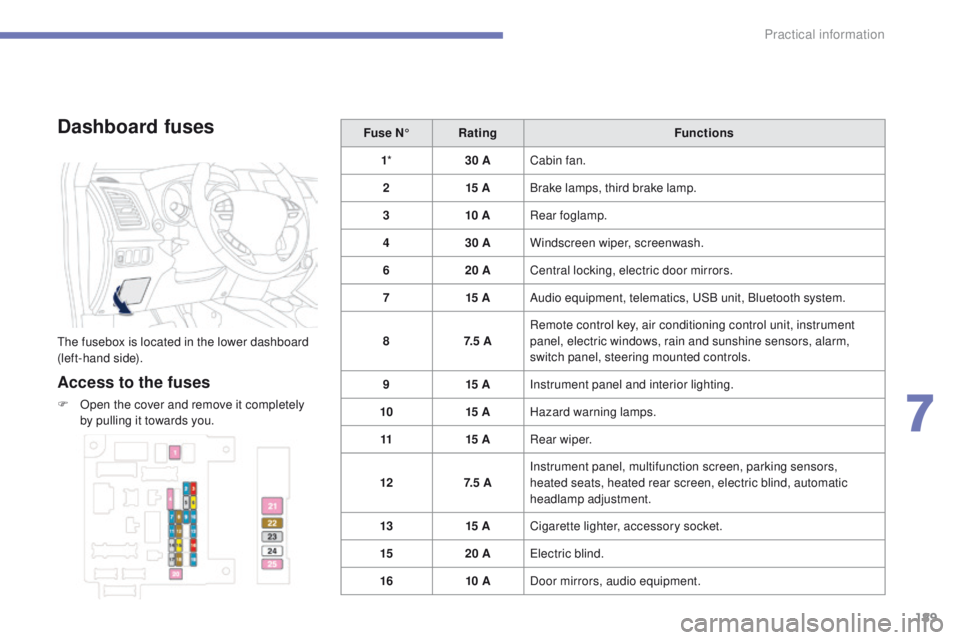
189
4008_en_Chap07_info-pratiques_ed01-2014
Dashboard fuses
the fusebox is located in the lower dashboard
(left-hand side).
Access to the fuses
F Open the cover and remove it completely by pulling it towards you. Fuse N°
Rating Functions
1 * 30 ACabin fan.
2 15 ABrake lamps, third brake lamp.
3 10 ARear foglamp.
4 30 AWindscreen wiper, screenwash.
6 20 ACentral locking, electric door mirrors.
7 15 AAudio equipment, telematics, u
S
B unit, Bluetooth system.
8 7. 5 ARemote control key, air conditioning control unit, instrument
panel, electric windows, rain and sunshine sensors, alarm,
switch panel, steering mounted controls.
9 15 AInstrument panel and interior lighting.
10 15 AHazard warning lamps.
11 15 ARear wiper.
12 7. 5 AInstrument panel, multifunction screen, parking sensors,
heated seats, heated rear screen, electric blind, automatic
headlamp adjustment.
13 15 ACigarette lighter, accessory socket.
15 20 A
ele
ctric blind.
16 10 ADoor mirrors, audio equipment.
7
Practical information
Page 204 of 389

202
4008_en_Chap07_info-pratiques_ed01-2014
Driving advice
Distribution of loads
F Distribute the load in the trailer so that the heaviest items are as close as possible to
the axle and the nose weight approaches
the maximum permitted without
exceeding
it.
Air density decreases with altitude, thus
reducing engine performance. Above
1
000 metres, the maximum towing load must
be reduced by 10
% of the gt
W a
nd so on for
every 1
000 metres of altitude.
Refer to the "
te
chnical Data" section for details
of the weights and towing loads which apply to
your vehicle.
Side wind
F take into account the increased sensitivity to side wind.
Cooling
towing a trailer on a slope increases the
temperature of the coolant.
As the fan is electrically controlled, its cooling
capacity is not dependent on the engine speed.
F
t
o l
ower the engine speed, reduce your
speed.
th
e maximum towing load on a long slope
depends on the gradient and the outside
temperature.
In all cases, pay attention to the coolant
temperature.
F
I
f this message is displayed, stop your
vehicle as soon as it is safe to do so.
Braking
towing a trailer increases the braking distance.
Ty r e s
F Check the tyre pressures of the towing vehicle and of the trailer, observing the
recommended pressures.
Lighting
F Check the lighting and signalling on the t r a i l e r.
If the message flashes slowly, wait for the
engine to cool before topping up the level,
if
necessary.
If the message flashes rapidly, contact a
P
e
uge
Ot
dealer or a qualified workshop
without delay.
Practical information
Page 213 of 389

211
4008_en_Chap08_verifications_ed01-2014
Quality of the fuel used for
petrol engines
the petrol engines are per fectly compatible
with e1 0 type petrol biofuels (containing 10 %
ethanol), conforming to
e
u
ropean standards
eN 2
28 and e
N 1
5376.
e8
5 type fuels (containing up to 85 % ethanol)
are reserved exclusively for vehicles marketed
for the use of this type of fuel (BioFlex
vehicles).
t
h
e quality of the ethanol must
comply with
e
u
ropean standard e
N 1
5293.
For Brazil only, special vehicles are marketed
to run on fuels containing up to 100 % ethanol
(
e
10 0 t y p e).
Quality of the fuel used for
Diesel engines
the Diesel engines are per fectly compatible
with biofuels which conform to current and
future e
u
ropean standards (Diesel fuel
which complies with standard
e
N 5
90 mixed
with a biofuel which complies with standard
eN
14214) available at the pumps (containing
up to 7
% Fatty Acid Methyl e
s
ter).
th
e B30 biofuel can be used in certain Diesel
engines; however, this use is subject to strict
application of the special servicing conditions.
Contact a P
e
uge
Ot
dealer or a qualified
workshop.
th
e use of any other type of (bio)fuel
(vegetable or animal oils, pure or diluted,
domestic fuel...) is strictly prohibited (risk of
damage to the engine and fuel system).
1.6 litre petrol engines, even though they have
been designed to operate on 95 RON petrol,
can accept 90 RON petrol without engine
adjustments, but with a slight deterioration in
performance.
2.0 litre petrol engines can accept 90 RON or
higher petrol.
8
Checks
Page 220 of 389
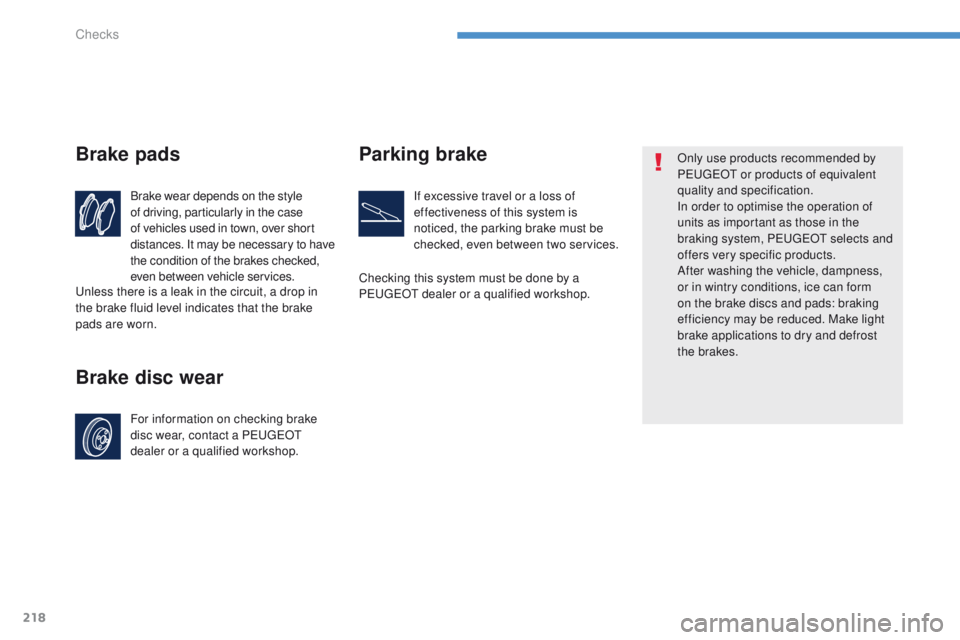
218
4008_en_Chap08_verifications_ed01-2014
Brake wear depends on the style
of driving, particularly in the case
of vehicles used in town, over short
distances. It may be necessary to have
the condition of the brakes checked,
even between vehicle services.
Brake pads
For information on checking brake
disc wear, contact a PeugeOt
dealer or a qualified workshop.
Brake disc wear Parking brake
If excessive travel or a loss of
effectiveness of this system is
noticed, the parking brake must be
checked, even between two services.
Only use products recommended by
P
e
uge
Ot
or products of equivalent
quality and specification.
In order to optimise the operation of
units as important as those in the
braking system, P
e
uge
Ot
selects and
offers very specific products.
After washing the vehicle, dampness,
or in wintry conditions, ice can form
on the brake discs and pads: braking
efficiency may be reduced. Make light
brake applications to dry and defrost
the brakes.
Checking this system must be done by a
P
e
uge
Ot
dealer or a qualified workshop.
un
less there is a leak in the circuit, a drop in
the brake fluid level indicates that the brake
pads are worn.
Checks
Page 222 of 389
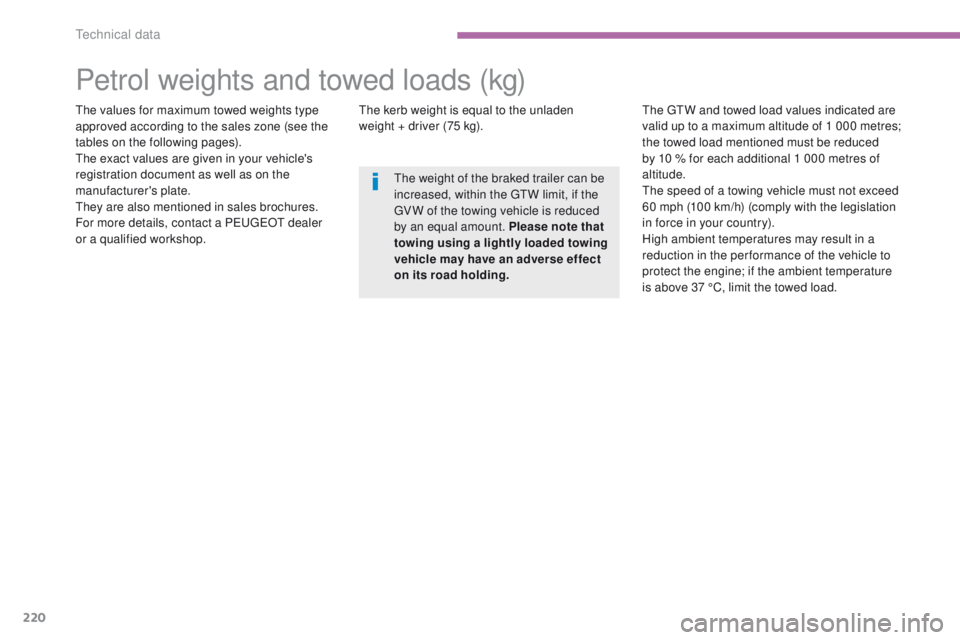
220
4008_en_Chap09_caracteristiques-techniques_ed01-2014
Petrol weights and towed loads (kg)
the values for maximum towed weights type
approved according to the sales zone (see the
tables on the following pages).
th
e exact values are given in your vehicle's
registration document as well as on the
manufacturer's plate.
th
ey are also mentioned in sales brochures.
For more details, contact a P
e
uge
Ot
dealer
or a qualified workshop.th e kerb weight is equal to the unladen
weight + driver (75 kg).th e gtW a nd towed load values indicated are
valid up to a maximum altitude of 1 000 metres;
the towed load mentioned must be reduced
by 10 % for each additional 1 000 metres of
altitude.
th
e speed of a towing vehicle must not exceed
60 mph (100 km/h) (comply with the legislation
in force in your country).
High ambient temperatures may result in a
reduction in the per formance of the vehicle to
protect the engine; if the ambient temperature
is above 37 °C, limit the towed load.
th
e weight of the braked trailer can be
increased, within the
gt
W l
imit, if the
gV
W of the towing vehicle is reduced
by an equal amount. Please note that
towing using a lightly loaded towing
vehicle may have an adverse effect
on its road holding.
technical data
Page 229 of 389
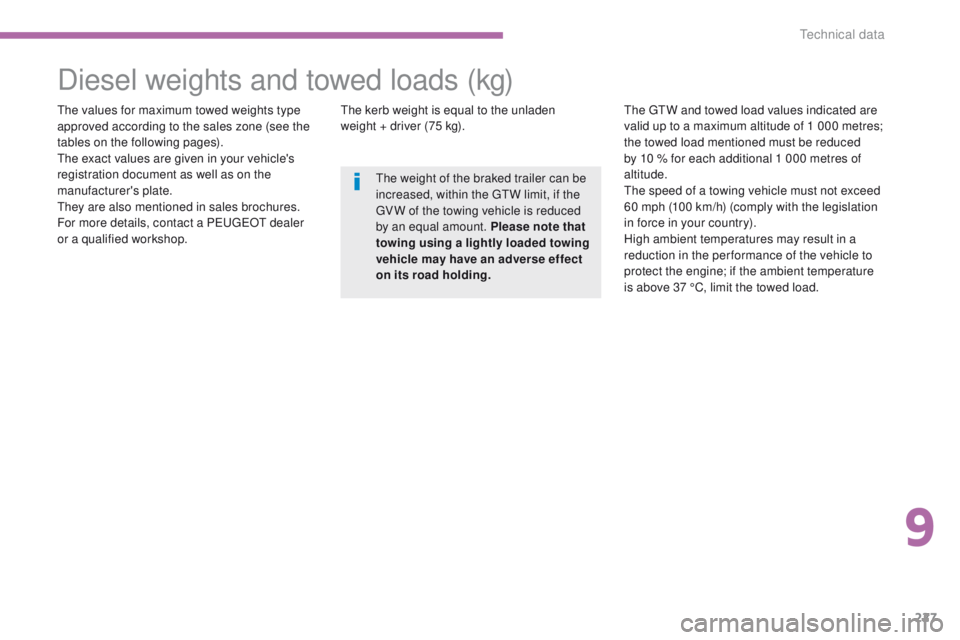
227
4008_en_Chap09_caracteristiques-techniques_ed01-2014
Diesel weights and towed loads (kg)
the values for maximum towed weights type
approved according to the sales zone (see the
tables on the following pages).
th
e exact values are given in your vehicle's
registration document as well as on the
manufacturer's plate.
th
ey are also mentioned in sales brochures.
For more details, contact a P
e
uge
Ot
dealer
or a qualified workshop.th e kerb weight is equal to the unladen
weight + driver (75 kg).th e gtW a nd towed load values indicated are
valid up to a maximum altitude of 1 000 metres;
the towed load mentioned must be reduced
by 10 % for each additional 1 000 metres of
altitude.
th
e speed of a towing vehicle must not exceed
60 mph (100 km/h) (comply with the legislation
in force in your country).
High ambient temperatures may result in a
reduction in the per formance of the vehicle to
protect the engine; if the ambient temperature
is above 37 °C, limit the towed load.
th
e weight of the braked trailer can be
increased, within the
gt
W l
imit, if the
gV
W of the towing vehicle is reduced
by an equal amount. Please note that
towing using a lightly loaded towing
vehicle may have an adverse effect
on its road holding.
9
technical data